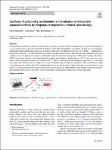Item Infomation
Full metadata record
| DC Field | Value | Language |
|---|---|---|
| dc.contributor.author | Felix, Leibetseder | - |
| dc.contributor.author | Julia, Bičvić | - |
| dc.contributor.author | Klaus, Bretterbauer | - |
| dc.date.accessioned | 2023-04-20T08:07:41Z | - |
| dc.date.available | 2023-04-20T08:07:41Z | - |
| dc.date.issued | 2023 | - |
| dc.identifier.uri | https://link.springer.com/article/10.1007/s00706-023-03037-8 | - |
| dc.identifier.uri | https://dlib.phenikaa-uni.edu.vn/handle/PNK/8162 | - |
| dc.description | CC BY | vi |
| dc.description.abstract | Common linear polymers are known to undergo phase changes at the glass-transition temperature (Tg) and the melting point (Tm). In recent years, it has also been shown that molecules with long aliphatic side chains can give rise to a backbone-independent melting phenomenon, known as nanophase separation. This effect describes the self-assembly — independent of the polymer backbone — of alkyl side chains into semi-crystalline nanostructures. This work presents optimized, gram scale synthesis routes for dodecyl and octadecyl acrylamide and their respective homopolymers. Differential scanning calorimetry (DSC) experiments detected a broad endothermal signal for poly(n-dodecyl acrylamide) at − 29 °C and a narrower, more intense signal for poly(n-octadecyl acrylamide) at 34 °C. These signals indicate the nanophase separation TM of the alkyl side chains. | vi |
| dc.language.iso | en | vi |
| dc.publisher | Springer | vi |
| dc.subject | DSC | vi |
| dc.subject | glass-transition temperature | vi |
| dc.title | Synthesis of poly(n-alkyl acrylamides) and evaluation of nanophase separation effects by temperature-dependent infrared spectroscopy | vi |
| dc.type | Book | vi |
| Appears in Collections | ||
| OER - Khoa học Tự nhiên | ||
Files in This Item:

